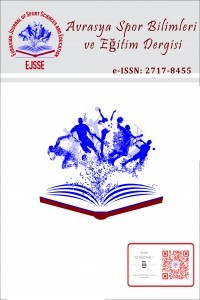Differences Between Motor Abilities of First And Second League Soccer Players in Kosovo
In this research is applied a sample of 159 soccer players from Kosovo, 79 of them from the first league and 80 others from the second league, aged 18-33 years old. The aim of this research is the evaluation of motoric skills of the soccer players from the fist and the second league, and the comparison between them. To prove motoric abilities, 9 variables are applied: Standing long jump, Standing high jump, Standing triple jump, foot-tapping against the wall, 20m run, 50m run, ball lead slalom 20m, work with the ball, ball lead 20m in corridors. In this research are applied these methods of result elaboration: basic statistical parameters and the correlation between motoric space variables. In order to prove statistically valid changes between researched groups is applied T-test. The most noticeable difference is shown in the variable work with the ball 27 -15, whereas a small change between two groups of soccer players is noticed to the Standing high jump. The effect of more qualitative trainings is noticed in favor of the first league soccer players. After basic statistic parameters analyzed in motor space is concluded that exist systematic differences in favor of the first league soccer players. Based on the value of gained skills is formed the Kosovo soccer players model.
Anahtar Kelimeler:
Soccer, first and second league, motoric abilities
Differences Between Motor Abilities of First And Second League Soccer Players in Kosovo
In this research is applied a sample of 159 soccer players from Kosovo, 79 of them from the first league and 80 others from the second league, aged 18-33 years old. The aim of this research is the evaluation of motoric skills of the soccer players from the fist and the second league, and the comparison between them. To prove motoric abilities, 9 variables are applied: Standing long jump, Standing high jump, Standing triple jump, foot-tapping against the wall, 20m run, 50m run, ball lead slalom 20m, work with the ball, ball lead 20m in corridors. In this research are applied these methods of result elaboration: basic statistical parameters and the correlation between motoric space variables. In order to prove statistically valid changes between researched groups is applied T-test. The most noticeable difference is shown in the variable work with the ball 27 -15, whereas a small change between two groups of soccer players is noticed to the Standing high jump. The effect of more qualitative trainings is noticed in favor of the first league soccer players. After basic statistic parameters analyzed in motor space is concluded that exist systematic differences in favor of the first league soccer players. Based on the value of gained skills is formed the Kosovo soccer players model.
Keywords:
Soccer, first and second league, motoric abilities,
___
- Akçakaya, İ. (2009). Compare anthropometric and motoric features of some players are in the trakya university athletics, basketball and football teams (Unpublished master’s thesis). Trakya University, Edirne, Turkey.
- Atan, T., Ayyıldız, T., & Ayyıldız, P. A. (2012). Some physical fitness values of female athletes engaged in different team sport branches. Selçuk University Journal of Physical Education and Sport Science, 14(2), 277-282.
- Atan, T., Eliöz, M., Çebi, M., Ünver, Ş., & Atan, A. (2016). Investigation of the effect of basketball training on motoric skills of the educable mentally retarded children. Journal of Sports and Performance Researches, 7(1), 29-35.
- Duyul, M. (2005). Comparation of effects to succes of motor values and antropometrik characteristics of handball, volleyball and football player university teams (Unpublished master’s thesis). Ondokuz Mayıs University, Samsun, Turkey.
- Dündar, U. (2015). Antrenman teorisi (9th ed.). Ankara: Nobel Akademik Publishing.
- Eniseler, N. (2010). Bilimin ışığında futbol antrenmanı (1st ed.). Manisa: Birleşik Printing.
- Hoshikawa, Y., Iida, T., Muramatsu, M., Nakajima, Y., Fukunaga, T., & Kanehisa, H. (2009). Differences in thigh muscularity and dynamic torque between junior and senior soccer players. Journal of sports sciences, 27(2), 129-138.
- Lehance, C., Binet, J., Bury, T., & Croisier, J. L. (2009). Muscular strength, functional performances and injury risk in professional and junior elite soccer players. Scandinavian Journal of Medicine & Science in Sports, 19(2), 243-251.
- Reilly, T., Bangsbo, J., & Franks, A. (2000). Anthropometric and physiological predispositions for elite soccer. Journal of sports sciences, 18(9), 669-683.
- Saygın, Ö. (2001). The effects of training programme in preparation period on some physicll and physiological parameters of professional soccer players. Journal of Physical Education and Sport Sciences, 1(3), 102-107.
- Sevim, Y. (2006). Basketbol teknik taktik antrenman (6th ed.). Ankara: Nobel Press.
- Spencer, M., Bishop, D., Dawson, B., & Goodman, C. (2005). Physiological and metabolic responses of repeated-sprint activities. Sports Medicine, 35(12),1025-1044.7. https://doi.org/10.2165/00007256-200535120-00003.
- Stølen, T., Chamari, K., Castagna, C., & Wisløff, U. (2005). Physiology of soccer. Sports medicine, 35(6), 501-536.
- Suchomel, T. J., Nimphius, S., & Michael, S. H. (2016). The Importance of muscular strength in athletic performance. Sports Medicine, 46(10),1419-49. https://doi.org/10.1007/s40279-016-0486-0.
- Wisloff, U., Castagna, C., Helgerud, J., Jones, R., Hoff, J. (2004). Strong correlation ofmaximal squat strength with sprint performance and vertical jump height in elitesoccer players. British Journal of Sports Medicine 38: 285–288. http://dx.doi.org/10.1136/bjsm.2002.002071.
- Yılmaz, I., Yanardag, M., Birkan, B., & Bumin, G. (2004). Effects of swimming training on physical fitness and water orientation in autism. Pediatrics International, 46(5), 624-626. https://doi.org/10.1111/j.1442-200x.2004.01938.x.
- Yılmaz, T. (2012). The effect of 8-week swimming exercises on adolescents aerobic powers, respiratory function and body balance (unpublished doctoral dissertation). Selçuk University, Konya, Turkey.
- Yayın Aralığı: Yılda 2 Sayı
- Başlangıç: 2019
- Yayıncı: Nazmi SARITAŞ
